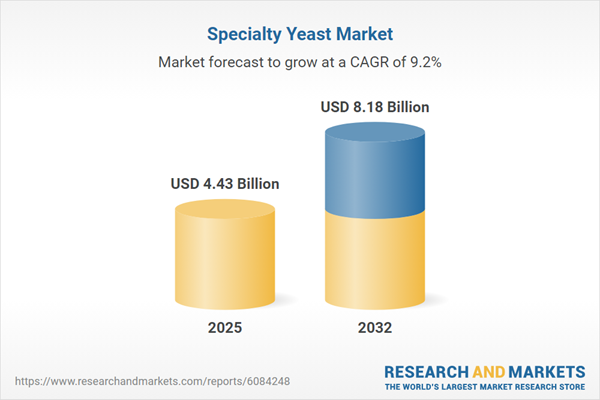Speak directly to the analyst to clarify any post sales queries you may have.
Specialty yeast is redefining production standards across bakery, brewing, and biotech industries as innovation and cross-sector collaboration intensify. Organizations are swiftly adapting to evolving consumer expectations and regulatory frameworks, positioning specialty yeast as a growth catalyst within modern manufacturing ecosystems.
Specialty Yeast Market Snapshot
The Specialty Yeast Market grew from USD 4.05 billion in 2024 to USD 4.43 billion in 2025. It is expected to continue growing at a CAGR of 9.18%, reaching USD 8.18 billion by 2032. Rapid advancements in metabolic engineering and precision fermentation are driving demand across diverse applications, from clean-label bakery solutions to functional biofuel production. Companies are leveraging yeast’s ability to optimize flavor, nutrition, and efficiency, fostering market expansion. Regulatory focus on sustainability and transparency is accelerating the uptake of plant-based alternatives and advanced fermentation technology.
Scope & Segmentation of the Specialty Yeast Market
This report provides in-depth coverage of all critical segments shaping the specialty yeast sector, leveraging the latest research and industry feedback:
- Product Types: Baking Yeast (Active Dry Yeast, Fresh Yeast, Instant Dry Yeast), Brewer’s Yeast (Ale Yeast, Lager Yeast), Distiller’s Yeast (Industrial Yeast, Spirits Yeast), Nutritional Yeast (Flakes, Powder), Probiotic Yeast (Saccharomyces Boulardii).
- Forms: Dry Yeast (Active Dry Yeast, Instant Dry Yeast), Liquid Yeast (Compressed Yeast, Cream Yeast).
- Applications: Animal Feed, Bakery, Biofuel (Fuel Ethanol, Industrial Ethanol), Brewing, Distilling (Industrial Yeast, Spirits Yeast), Nutraceuticals, Pharmaceuticals.
- Distribution Channels: Offline (Retail, Wholesale), Online (Direct Sales, E-Commerce Platform).
- Regions: Americas (United States, Canada, Mexico, Brazil, Argentina, Chile, Colombia, Peru), Europe, Middle East, & Africa (including United Kingdom, Germany, France, Russia, Italy, Spain, Netherlands, Sweden, Poland, Switzerland, United Arab Emirates, Saudi Arabia, Qatar, Turkey, Israel, South Africa, Nigeria, Egypt, Kenya), Asia-Pacific (China, India, Japan, Australia, South Korea, Indonesia, Thailand, Malaysia, Singapore, Taiwan).
- Covered Companies: Lesaffre SA, Lallemand Inc., Angel Yeast Co., Ltd., AB Mauri (Associated British Foods plc), Chr. Hansen Holding A/S, Koninklijke DSM N.V., Kerry Group plc, Alltech, Inc., Oriental Yeast Co., Ltd., Biorigin Alimentos e Ingredientes Ltda.
Key Takeaways: Strategic Insights for Decision-Makers
- Novel yeast strain development and digital process tools are rapidly enhancing flavor profiles, nutritional value, and fermentation outcomes across food and biotech sectors.
- Cross-industry partnerships among research institutions, suppliers, and manufacturers are accelerating the translation of scientific breakthroughs into commercially viable solutions.
- Shifting consumer preferences towards plant-based, clean-label products are prompting organizations to invest in yeast-derived proteins, enzymes, and probiotics.
- Sustainability is now central: closed-loop production and traceability systems are being prioritized to address regulatory and end-customer demands.
- Market segmentation is enabling suppliers to diversify and target high-value growth, notably in bakery, nutraceutical, animal feed, and functional beverage niches.
Tariff Impact: Navigating 2025 Trade Policy Changes
New United States tariffs set for 2025 are compelling specialty yeast stakeholders to reconsider sourcing and logistics. Companies are diversifying supplier networks, opting for regional production, and adopting agile strategies to sustain margins while securing essential raw materials. Investments in local fermentation capacity and supply chain resilience are key responses, reducing dependency on volatile trade corridors.
Methodology & Data Sources
Research findings are based on a mixed-method approach, including direct interviews with industry leaders, fermentation experts, and procurement specialists. These insights were cross-referenced with secondary sources, such as peer-reviewed journals, trade publications, and official company disclosures. Rigorous data validation and scenario analysis ensured a reliable, actionable perspective on sector dynamics.
Why This Report Matters
- Enables strategic planning with granular analysis of specialty yeast product, form, application, and distribution trends across major and emerging markets.
- Offers guidance for navigating complex regulatory environments and changing trade policies influencing cost structures and compliance standards.
- Supports competitive benchmarking and partnership decisions with detailed profiles of leading and regional specialty yeast manufacturers.
Conclusion
The specialty yeast sector stands at the intersection of innovation, sustainability, and shifting consumer demand. Organizations that leverage targeted R&D, supply chain agility, and collaborative networks are poised to achieve sustainable growth amidst an evolving global landscape.
Table of Contents
3. Executive Summary
4. Market Overview
7. Cumulative Impact of Artificial Intelligence 2025
Companies Mentioned
The companies profiled in this Specialty Yeast market report include:- Lesaffre SA
- Lallemand Inc.
- Angel Yeast Co., Ltd.
- AB Mauri (Associated British Foods plc)
- Chr. Hansen Holding A/S
- Koninklijke DSM N.V.
- Kerry Group plc
- Alltech, Inc.
- Oriental Yeast Co., Ltd.
- Biorigin Alimentos e Ingredientes Ltda
Table Information
| Report Attribute | Details |
|---|---|
| No. of Pages | 189 |
| Published | October 2025 |
| Forecast Period | 2025 - 2032 |
| Estimated Market Value ( USD | $ 4.43 Billion |
| Forecasted Market Value ( USD | $ 8.18 Billion |
| Compound Annual Growth Rate | 9.1% |
| Regions Covered | Global |
| No. of Companies Mentioned | 11 |









